AFRICAN HEBREW ISRAELITES OF JERUSALEM (AHIJ) TIMELINE
1939 (October 12): Ben Carter (later, Ben Ammi) was born in Chicago, Illinois.
1959 (October 15): Carter married Patricia Price, who would later be known as Adinah Carter.
1963: Ben Carter heard first of the theory of African American descent from Israelites.
1964: Carter and several others founded the Abeta Hebrew Culture Center in Chicago’s Southside.
1966: Ben Ammi received a revelation instructing him to take his people back to the Promised Land.
1967 (April 24): Abeta met on Passover, expecting to be transported out of America
1967 (May 17): Ammi and two colleagues travelled to Liberia to scout. They took on the name Representative Government of the Immigrants
1967 (July 7): The first group left for Liberia.
1967 (September 19): Ben Amm, with twenty others, left Chicago for Liberia.
1968 (April 3): Martin Luther King’s mountaintop speech inspired Ben Ammi to announce the intention to move to Israel.
1968 (May 1): Ben and Hezkiyahu Blackwell left for Israel.
1969 (December 21): The second group, of thirty-nine, arrived in Israel.
1970 (Mar 6): The final group, including the leadership, arrived in Israel.
1970 (April): The AHIJ began petitioning the UN subcommittee on Human Rights for residence and recognition as a third party in Israel alongside Jews and Arabs.
1970: Louis A. Bryant joined the group and brought his own followers with him to Israel. He took the name Shaleak Ben Yehuda.
1971: Warren Brown joined the AHIJ and took the name Asiel Ben Israel.
1972 (January): AHIJ member Cornell Kirkpatrick was killed in a brawl with other members. Six members were sentenced for manslaughter.
1973 (October): Seventy-five members renounced their U.S. citizenship after Israel announced plans to deport all of them..
1974: Jacques Amir (Labor Party, Dimona) raised the issue in the Knesset and was appointed chairman of a subcommittee to investigate the grou.
1974: Shaleak ben Yehuda founded the School of the Prophets.
1975: Shaleak ben Yehuda’s book, Black Hebrew Israelites from America to the Promised Land was published.
1977 (September 22): The predicted apocalypse did not occur. Ben Ammi was crowned in a public ceremony as King of Kings and Lord of Lords and announced the old age of the Euro-gentiles, the “Dominion of Deception” had now ended and the New World Order had begun.
1977 (December 21-28): The Commission for the Elimination of Racism of the New York Council of Churches made a visit to Israel to look into Dimona and the situation there.
1978 (March): The AHIJ were accepted into the Histadrut, meaning they had the right to work.
1978 (August 4): The Glass Committee was appointed to investigate the AHIJ.
1979 (January 14): Ben Ammi wrote a conciliatory letter to Interior Minister Joseph Burg.
1980 (June): The Glass Report was delivered.
1981 (January 17-28): The BASIC delegation visited Israel and the AHIJ.
1981: Ex-member Thomas Whitfield’s book, From Night to Sunlight, was published, documenting petty crime and abuse of members by the leadership.
1982: Ben Ammi’s first book, God, the Black Man and Truth was published.
1983 (March 8): Congressman Mervyn M. Dymally presented the group’s case to the House of Representatives.
1983 (November 15): A letter from the Black Caucus to Interior Minister Burg was received, referencing the Glass Report and asking the AHIJ be allowed to stay.
1985 (July): Thirty-two members were arrested in America on various fraud charges. All were charged; Asiel and three others were convicted.
1986 (April 17): Forty-six members were arrested in Israel for working illegally, and deported.
1986 (April 22): The “Day of the Show of Strength” took place. Police and military arrived in Dimona to prevent a planned march to Jerusalem in protest of the deportations.
1987 (April 29): Ben Ammi met with the American Jewish Congress and anti-Defamation League representatives in Israel to express regret over previous antisemitism and anti-Zionism, and the beginning of a new outlook.
1987 (April 30): Ben Ammi put out a Press Release renouncing all antisemitic, anti-Jewish and anti-Zionist claims previously made and expressing a desire to work together with Israel as Israelites.
1989: Interior Minister Aryeh Deri visited the Village of Peace
1990: Negotiations began between the AHIJ, Israel, and the U.S.
1991 (May): Temporary Residence visas were granted to community members.
2003 (August): The AHIJ were granted permanent residence status
2005 (February): The Dr. Martin Luther King/SCLC – Ben Ammi Institute for a New Humanity opened in Dimona.
2009: The first non-Israel born member of AHIJ gained Israeli citizenship
2013: Ben Ammi gained citizenship.
2014 (December 12): Ben Ammi died.
FOUNDER/GROUP HISTORY
The African Hebrew Israelites of Jerusalem are one group or denomination within the (Black) Hebrew Israelite movement. Hebrew Israelites (who nowadays prefer to remove the descriptor Black from the name) believe that the biblical Israelites were a Black African people, and that African Americans are their descendants. Some believe they are the only descendants, while some believe that Ashkenazi and other rabbinic Jews are also authentic descendants. The movement began at the end of the nineteenth century in the American south, when two or three ex-slaves who were ministers and Prince Hall Freemasons, received visions informing them that Blacks were Jews, and to take a new path in their preaching. The churches they founded spread across the U.S. (and further afield) throughout the twentieth century, with other individuals receiving their own visions along the way. The most well-known is perhaps Wentworth Arthur Matthew, a Caribbean immigrant who in 1919 founded the Commandment Keepers church/synagogue in Harlem, New York (Landing 2002; Dorman 2013).
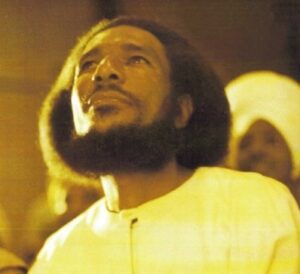
Ben Carter [Image at right] was born in 1939, in Chicago’s South Side. The youngest of six children, his family had moved from Mississippi during the Great Migration of southern Blacks to northern cities. He was raised as a Baptist, and worked as a metallurgist. It was at his workplace in 1963 that a co-worker introduced him to the idea that African Americans were descended from Israelites (although he would later claim to have been told this by his parents). He began attending meetings organised by Lucius Casey, but quickly helped to found a new organisation, the Abeta Hebrew Culture Center. He received the new name Ben Ammi (“Son of my people”) from one of his teachers (all of whom were trained by Wentworth Matthew). During the racial turbulence of 1966, he received a revelation instructing him to take his people back to the Promised Land, and another Abeta member calculated that Passover of 1967 (April 24) was the biblically ordained date for this exodus. Although the group met on that date, miraculous transportation did not appear, leading them to begin planning their own journey. Having settled on the destination of Liberia, they arrived in several groups and with the help of a previous American expat purchased land on which they began farming and living. Some members knew that Liberia was only a temporary stage in the journey, but many did not. After some difficulties with their life in rural Liberia, as well as with the Liberian authorities, it was in Martin Luther King’s final speech that he invoked Moses. He claimed to have seen the Promised Land that African Americans as a people would reach, and that was taken as a sign that the time was right to progress to their final destination, Israel. Thus, in April of 1968 they began making plans to relocate again (HaGadol 1993).
Ben Ammi and one of his closest aides, Hezkiyahu Blackwell, visited Israel and the latter enrolled in a kibbutz in order to become fluent in modern Hebrew and comprehend the immigration system. From the end of 1969, other members arrived in three groups: first five, then thirty-nine, then the remaining seventy-five. The first were welcomed as unexpected new Jewish immigrants and given citizenship with full rights, but as subsequent groups arrived, they were met with more suspicion. Ultimately the whole group crammed into the few apartments granted to the first families, in the Negev cities of Dimona, Arad, and Mitzpe Ramon.
Relations with the Israeli state deteriorated quickly as members were threatened with deportation and at one point compared unfavourably with the PLO. The AHIJ responded with accusations of racism and asserted that Jews were European invaders of a land that was rightfully their own. They quickly began petitioning the United Nations to be considered, if not the rightful heirs of the land, then at least a third party with national rights alongside the Jews and Palestinians. In January of 1972, one member was killed in a brawl; six members were later convicted of manslaughter, all of which confirmed the worst suspicions about the group. Immigration officials began turning away new arrivals suspected of being members. As they began expressing antisemitic tropes and threatening divine punishment if they were not given full rights, Israel announced plans to deport them. In October of 1973, seventy-five members formally renounced their U.S. citizenship, rendering themselves stateless and thus un-deportable.
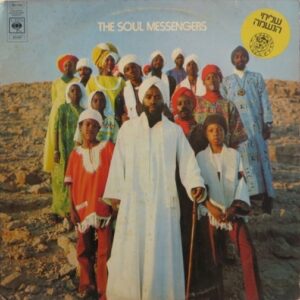
Despite conflict with the state, they found good relations with their neighbours in the southern cities, [Image at right] who were largely recent Jewish immigrants from North Africa and India. During the Yom Kippur War of October 1973, they shared the experience of huddling in air raid shelters together, and their acclaimed funk-soul band The Soul Messengers toured the country, playing for the IDF troops. Their lack of legal status caused manifold problems as most members had no right to work, education or healthcare. They were also regularly smuggling in new members from the U.S., disguised as Christian pilgrims, thus applying further stress to the already struggling resources to which they had access. Throughout the 1970s, they were a regular feature in Knesset discussions and the Israeli press, who usually painted a very negative picture. Some accusations were justified; indeed, in 1977 it was revealed that the FBI had uncovered a sophisticated operation of credit card fraud and stolen airline tickets which had been supplying the AHIJ with money. Defectors also described oppressive conditions, authoritarian rule and tortuous punishments for disobedience. One high ranking member (Shaleak Ben Yehuda) published a book in 1975 which made a wealth of antisemitic claims about the demonic nature of Jews and their influence in the enslavement of the “authentic” African Israelites. Apocalyptic predictions focused on the year 1977, at which time America would be destroyed in a nuclear war and African Americans would take control of Israel and leadership of the world (Miller 2021b). Despite this, when the Commission for the Elimination of Racism of the New York Council of Churches visited Dimona to investigate the situation there, they left with a very favourable impression of the group.
However, by at least 1978, possibly before, the AHIJ made significant attempts to reach out to Israelis, making several public statements that they would accept the responsibilities and restrictions of Israeli citizenship if offered, and were open to any negotiations with the only condition being that they were allowed to remain in Israel. Following sustained pressure from American Jewish organisations (who were concerned with the potential ruination of U.S. Black-Jewish relations), and the recommendation of Histadrut members in the Negev, the Histadrut (Israel’s national trades union) accepted all existing AHIJ members, thereby granting them employment rights. They also recommended that members receive education and health rights.
In January 1979, Ben Ammi wrote to Interior Minister Joseph Burg that:
We regard ourselves as Israelis bound up with the fate of the state of Israel both spiritually and physically […] We do not wish to do anything which would create problems or distress to the state […] We are not now, and shall not be in the future, negative factors for the state of Israel – I confess, without going into details, that when we first came to Israel, we had an outsider’s concept […] we will be productive citizens.
They wished “to stay in the Land of Israel and to serve the God of our fathers, Abraham, Isaac and Jacob.” Ammi specifically pledged that, “if we are so requested, we shall not add illegally a single person to our community, and we shall continue to try to convince the State of Israel” to accept other Hebrew Israelites “only through official channels.” He concluded that he hoped to open a new chapter of positive cooperation and suggested that “our community works for the State of Israel abroad and can bring about fascinating results in America and Africa” (Gruen 1983). Other parties also felt there had been a change in tone and outlook, both from the leadership and the members.
Despite being granted a disused housing complex by Dimona’s local government in 1980, which solved their overcrowding problem and the subsequent side-effects which impacted other locals), and an official Knesset investigative committee (The Glass Committee), which decided that the best overall plan was for them to be allowed to remain and granted the rights of residence, Israeli government discussions had long favoured a policy of expelling the leadership and letting the community disintegrate. The only reason for this not happening was, not Israeli indecision, as previous commentators have suggested, but the U.S.’s blanket rejection of the option. The Israeli State Archives show that the U.S. had always refused to accept any member who had renounced their American citizenship, and even threatened to respond by returning the members to Israel, along with Israelis with criminal records. That response caused uproar in Israel’s Interior Ministry, but it was powerless to alter it. The reasons for this rigid position are unclear, although possibly the U.S. thought the AHIJ was better as Israel’s problem than their own. The U.S. had only just managed in the 1960s and 1970s to contain the threat of several other Black revolutionary groups including the paramilitary Black Liberation Army. The U.S may have perceived Ben Ammi as a potential agitator they could do without.
Later in 1980, one defector, Thomas Whitfield, published a book detailing his time and crimes with the AHIJ. In January 1981, a BASIC (Black Americans in Support of Israel Committee) group visited, led by Bayard Rustin. Their investigation concluded that Israel had not demonstrated racism, and accepted the recommendations of the Glass Report that the AHIJ should be allowed to remain, with a path towards citizenship. In April 1984, Asiel responded to the lack of progress with a press conference during which he announced that Israel was planning to execute the community, and offering veiled threats to American Jews. Louis Farrakhan joined him and made some venomously antisemitic and anti-white comments in the following days. This appears to have triggered a stronger wave of persecution, and members who had not renounced their citizenship were increasingly targeted for deportation, culminating in the expulsion of forty-nine members found working illegally in April 1986. The community planned to march from Dimona to Jerusalem in protest but found their journey prevented by a troop of 600 armed police, civil defence troops and border police. Surrounded, Ammi instructed his people to stand their ground, sing and fast. That event would go down in AHIJ mythology as the Day of the Show of Strength. By the next day it was agreed that they would not march and the army would leave.
Later that year, the American trial of thirty-two members resulted in the imprisonment of Asiel and three others. They were found guilty of bank and credit card fraud and the theft of airline tickets, on a massive scale. The first conviction was overturned on a technicality, but they pled guilty at second trial in 1988 (Asiel was further found guilty of illegal lobbying on behalf of the Zimbabwe government in 2014). Regarding the fraud, Ben Ammi later stated: “We did not authorize any criminal activity. When our predicament in Israel deteriorated, we requested substantial assistance from the community in the U.S. I did not know any money was coming from illegal activities. But, I didn’t hold any investigations or ask any questions, either. Listen, we had to feed our children. We needed money” (Black 1987).
In April 1987, Ben Ammi issued a Press Release, “declaring a permanent cessation of the dissemination of all literature, statements and activities that are anti-Semitic, anti-Jewish or anti-Zionist,” and expressing a desire to work together with Israel as a united community of Israelites. The AHIJ reportedly destroyed all such literature in their possession. Ammi also met with the Israeli representatives of the American Jewish Congress and Anti-Defamation League, to inform them of the same, and to find a way forward. Some suspected that their repentance was not ideological but born of desperation as the imprisonment of their American fraud network had stripped the community of approximately $12,000 per month and Israel was slowly closing the possibilities of illegal employment. Furthermore, the Histadrut revoked their membership. At one point, the Ministry of Social Welfare was providing 350 daily hot lunches for AHIJ children, in order to avert mass starvation (Black 1987).
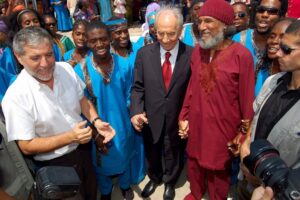
In 1989 Interior Minister Arye Deri of the Shas (Ultra-Orthodox) party visited their settlement in Dimona and determined that they were not a threat but potentially a positive influence, and one that could be integrated into Israel. [Image at right] It was at this point that negotiations between Israel, the AHIJ and the U.S. began, resulting in the community being granted temporary resident status in return for a commitment to bring no further members into Israel. Normalisation gradually followed, albeit slowly, with members being granted the option of citizenship from 2009. Upon being granted permanent resident status in 2003 one member enthusiastically stated, “I guess you can call this the best moment of my life.” Whatever Israeli suspicion of the community remained was destroyed when one member, thirty-two year old Aharon Ben-Israel Elis, was killed in a terrorist attack while playing with a band at a Bat Mitzvah near Haifa, in January 2002.
Ben Ammi died in December 2014, by which time the AHIJ numbered 2,500 people in Israel and several thousand in other countries. They had established an impressive network of communities in African states, where they contribute to community, building, and health projects, largely through their African Hebrew Development Agency. Yet they are based still in Dimona, in the housing complex known as the Village of Peace (Kfar haShalom). Years since have seen the AHIJ continue to pursue their goals of changing humanity’s focus from materialism to spiritual and community concerns, focusing especially on the environmental crisis. They consider themselves the spiritual leaders of humanity who are building the Kingdom of God in the Holy Land, which will produce the wisdom from which all of humanity will enter a new way of life (Singer 2000; Michaeli 2000; Jackson 2013; Miller 2021a).
DOCTRINES/BELIEFS
The fundamental belief of all Hebrew Israelite groups is that the ancient Israelites were Black Africans and that at least some African Americans are descended from them. This is the AHIJ’s position, although it has been formulated in more and less radical terms, depending on their relations with Israel. At the low points they held that all members of the normative Jewish community, and indeed even Samaritans and “white” Arabs were European transplants, descended from Medieval Crusaders. The peacebuilding efforts since the 1980s have seen them repeal such claims, instead stating that some Israelites migrated north and east, into Asia and Europe, where they seeded the Mizrachi, Sephardi, and Ashkenazi (rabbinic) communities, as well as others accepted as Jewish such as Indian and Chinese Jews. At other points they have asserted that Israelite identity is a matter of spiritual inclination, in which anyone can participate. However, they see their own community as at the forefront of the present era, and as those ordained to lead humanity out of the chaotic times into the Messianic Age.
The AHIJ consider the Hebrew Bible to be scripture, although it has usually been used in the King James translation and order, rather than that of the Jewish Tanakh. They consider the New Testament (principally the Gospels and Revelation) to be inspired recordings, but not infallible.
Ben Ammi has been the community’s principal theologian, authoring eleven books and countless lectures between 1982 and 2014. In these he set out his conception of history, truth, God, humanity and society. All of these beliefs are sourced in the Hebrew Bible, although the influence of previous generations of Hebrew Israelite and African American thought are clearly discernible.
Ammi is considered to be the Messiah, although this has a specific meaning. For the AHIJ there have been many messiahs, individuals ordained by God with the mission of bringing Israel back to the correct path. Ben Ammi is the latest in the line of such individuals, although the first since Yeshua (Jesus).
In the early stages, Ammi was apocalyptic, predicting the impending destruction of America and a cataclysmic nuclear war which would destroy the world order and allow the Kingdom of God (the AHIJ) to take its place as leaders of the world. This Messianic Age would spread peace and brotherhood across the globe, with all peoples becoming part of it. The predicted apocalypse of 1977 did not occur, leading Ammi to revise the predictions and assert that America (and the western “Euro-gentile” order) was in the process of passing away. The disappointment of these predictions is likely what led to a more conciliatory stance towards Israel, in combination with the AHIJ’s increasing lack of material resources once their fraud network was closed down in the 1980s.
Similarly, in the early sources there is a substantial amount of conspiracy theorising: the last 2,000 years of history have allegedly seen the near-complete whitewashing of Israelite nature, their replacement by Europeans, and the attempted eradication of evidence such as the Black Madonnas. In turn, by creating the pseudo-Israelite religion of Christianity, Europeans have succeeded in taking over the world and subjecting it to their violent, warlike natures. The enslavement and Christianisation of the Israelites represented the final coup-de-gras, of turning them into European zombies. The “resurrection” of Black America (drawing upon traditional African American interpretation of Ezekiel’s Valley of Dry Bones prophecy) was now taking place as they realised their true identity. The antisemitic elements, which in some members’ portrayals (though not Ben Ammi’s) saw Jews as particularly evil and directly descended from Israel’s mortal enemy Edom, demonstrate a similarity with both the Nation of Islam’s antisemitism and with that of white antisemites (Miller 2023).
Later years saw less aggressive and paranoid rhetoric, as their stability in Israel, lack of persecution, and their experience of living as part of a Jewish society, one not dominated by the specific racial tension of the U.S., allowed them to concentrate on their agenda of global uplift. While still principally concerned with Africana peoples, Ammi and the AHIJ focused their efforts on promoting their beliefs to all. These included the opening of several vegan restaurants in Israel, the U.S. and Africa, and the creation of the African Hebrew Development Agency, through which they worked in African states (principally Liberia, Ghana and Kenya) to assist with building projects, borehole drilling, preventive healthcare, environmental sustainability, and other social initiatives.
The AHIJ have been vegan since 1973, arguing that this is the correct and divinely-mandated human diet. This is based on their reading of Gen.1:29, where God gives to Adam and Eve “every seed-bearing plant on the face of the whole earth and every tree that has fruit with seed in it. They will be yours for food.” Veganism and a health-centred approach to life are core principles, and a central part of what they present to the world (Markowitz and Avieli 2020; Miller 2021c).
Veganism is only one part of a principled non-violent stance that has characterised the community since its inception. Drawing upon the philosophy of Martin Luther King, the AHIJ have always rejected violence as a means of achieving their goals. When the Israeli police and military surrounded them to prevent their protest march in April 1986, their response was to stand their ground and fast, thus neither continuing the march nor backing down. This event has taken mythical proportions in the AHIJ’s history, becoming known as the Day of the Show of Strength. In terms of the Israel-Palestine conflict, they consider that any use of violence by either side is wrong, but they believe that they have a responsibility to defend their homeland when it is attacked. This is what justifies the enrollment of the youth for national service.
Ammi’s theology is one of vitalism and immanence, understanding God as a spirit which does not intervene in the world directly, instead inhabiting human beings and guiding them towards righteous thoughts and actions. God’s principal nature is that of creator and life-giver, being the only source of positive generative power. Opposing God is satan (which Ammi never capitalises), the negative spiritual power which influences humans towards actions which are destructive, both of humans and of the created world generally. While righteous actions lead toward the generation of greater creative potential, those actions influenced by satan lead humans toward their ultimate death. The latter has been responsible for the Western/European world’s recent dominance, the Time of the Gentiles which is now coming to an end. This saw the enslavement of Israelites in America and the wanton destruction of the environment which makes life on earth possible (Miller 2023).
Ammi’s social philosophy is both revolutionary and conservative: he held that the present order must be destroyed completely, in order that the Kingdom of God emerge, but this Kingdom will see the return of (mostly) conservative social roles, the eradication of feminism, homosexuality, drug use, unrighteous entertainment and unrighteous lifestyles. Because God is the source of life, everything in life must be related back to the Divine in order to certify its correctness and ensure its sustainability. In particular this requires a “return” to Mosaic Law, through which God become manifest in the individual, community, and world (Miller 2023).
Ammi consistently argued that eternal life (physical immortality) was not just possible, but the natural, intended state of humanity. This would be reached gradually, lifespans increasing as the Messianic Age began. Death was introduced as a direct result of Adam and Eve’s disobedience, and as the AHIJ are retracing the steps of humanity back to Eden we will undo the primal sin and once again enter the perfect existence of Eden. Eden itself is Africa, and Israel is an integral part of Africa, termed by them North-Eastern Africa.
RITUALS/PRACTICES
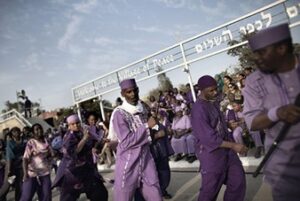
The community live by (their interpretation of) Mosaic Law. They keep Shabbat, meaning that from sunset on Friday to sunset on Saturday they fast and rest. Shabbat services with a sermon are held but these are not compulsory. As well as the biblically mandated festivals, they have a yearly celebration of New World Passover every May, commemorating their exodus from America (this joyful celebration attracts visitors from around the world). [An AHIJ festival] They are vegan and do not consume any intoxicants including tobacco, alcohol (except for especially brewed wine at festivals), and caffeine. Every member is expected to exercise three times per week. As well as spending three days every week eating only raw food, they have progressively instituted new annual dietary restrictions such as days where they consume no salt or no sugar. These are based on scientific findings about the health dangers of such substances. They wear only natural fibres, which are sewn by members of the community, and all must bear blue thread and fringes as mandated in the Bible (Deut.22:11-12, Num.15:37–40). Men wear a form of kippah and beards.
The community practice a form of polygyny which they term Divine Marriage. Herein, a man may marry up to seven wives, depending on his ability to support them. This is justified by appeal to biblical figures such as David, and some African tribal traditions. A minority of marriages are polygynous, and very few consist of more than two wives. These marriages, which go against Israeli law, are not formally recognised by the state. (Markowitz 2000)
Drawing on a long tradition within Black Hebrew Israelite groups, the AHIJ try to provide for their members’ needs internally. A large portion of the community’s food is self-farmed, and the community produces its own tofu, soya milk and soya ice cream, as well as many other food products. Clothing is produced, according to their interpretation of the biblical guidelines. Members run a recording studio to produce music and several eateries around Israel. The community in Dimona even has an internal taxi service, and many other businesses are run by members to serve the needs of the community. These businesses are presented as the best option for members (intended to keep the community’s finances circulating internally), but are also open to non-members. Whatever income is generated from these businesses, or from members’ external employment, are pooled and all members’ basic living expenses are paid centrally.
ORGANIZATION/LEADERSHIP
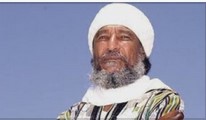
Ben Ammi [Image at right] has been the undisputed leader of the AHIJ since 1971, and de facto leader since their formation in Chicago. When Ammi solidified his status in 1971, he installed a tiered structure with a Holy Council of twelve Princes (Nasik in Hebrew) under him. In later years these were augmented with a tier of twelve Ministers (Sar), each of whom has a specific portfolio (economics, information, agriculture, education, sports, etc.) and Crowned Brothers and Sisters (atar/atarah), the point of regular contact for members (and the only leadership tier to include females). In addition, there is the Priesthood, who look after the spiritual needs of the community as well as officiating at services, marriages, counseling, and circumcisions (Jackson 2013).
Members of the community are known as “saints”, a tradition stretching back to the first Hebrew Israelite community of William Saunders Crowdy. The family is the basic unit of the community, which has a patriarchal structure, although husbands are commanded to listen to the input of their wives when making decisions. Women are educated and often work as well as taking care of the home.
For several decades Ben Ammi was supported by two principal individuals, Shaleak Ben Yehuda (Louis A. Bryant, 1927-2003), who led the School of the Prophets, the community’s higher education and priestly training institution, and Prince (Sar) Asiel Ben Israel (Warren Brown, 1941-2022), the community’s International and American Ambassador. The latter parted with Ben Ammi after disagreements arising from Ammi’s leadership style, specifically the enlisting of members in the Israeli army and the lack of transparency around decision-making, although he remained active in the U.S.
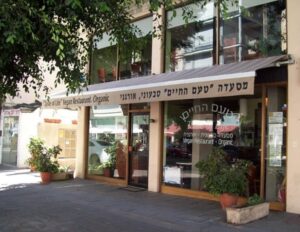
At an organizational level, AHIJ is comprised of a number of institutions and businesses. These organizations have missions related to education, non-violence, health and environment, and organic and vegan foods. [Image at right]
ISSUES/CHALLENGES
The biggest challenges to the AHIJ are largely in the past. They managed to establish themselves in Israel, and to defuse the threat of deportation.
The AHIJ faced two decades of conflict with the Israeli state from 1970 until 1990. This saw them demonised in popular reports and targeted for deportation. Largely, these threats have now ended and they are accepted 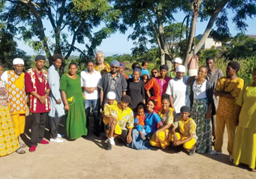 popularly and officially within the state. The achievement of their most important goal (permanent settlement in the Holy Land) has given them a renewed confidence. Indeed, they have become something of a model minority, serving in the army, creating small businesses, spending time with leaders, and receiving much positive coverage since then (Esensten 2019; Esensten website 2023). Both the AHIJ and Israel have benefited from these good relations, and they have sometimes acted as representatives of Israel (for example the Eurovision Song Contest in 1999, and at the Durban World Conference Against Racism in 2001). [Image at right] In April 2021, however, forty-six families whose legal status had not been resolved were issued with deportation orders; these were subsequently postponed after appeal, but the situation has not been resolved as of December 2022.
popularly and officially within the state. The achievement of their most important goal (permanent settlement in the Holy Land) has given them a renewed confidence. Indeed, they have become something of a model minority, serving in the army, creating small businesses, spending time with leaders, and receiving much positive coverage since then (Esensten 2019; Esensten website 2023). Both the AHIJ and Israel have benefited from these good relations, and they have sometimes acted as representatives of Israel (for example the Eurovision Song Contest in 1999, and at the Durban World Conference Against Racism in 2001). [Image at right] In April 2021, however, forty-six families whose legal status had not been resolved were issued with deportation orders; these were subsequently postponed after appeal, but the situation has not been resolved as of December 2022.
Ben Ammi’s death in December 2014 presented the greatest recent challenge to the AHIJ. The ensuing eight years have seen no major internal problems arise, however; the hierarchical leadership structure has helped to maintain focus and discipline, and the activities of the AHIJ continue to develop along the path already set out. What dissent there still is seems to be of little threat.
The disappointment of their literal apocalyptic predictions for 1977 led to some members leaving, but overall it was not very damaging. Indeed, as Festinger et al (1956) predict, the non-occurrence may have led to a greater assertiveness and Ben Ammi demonstrated a skillful ability to reinterpret his previous prophecies in order to make them compatible with a divergent reality, thus maintaining their veracity (Miller 2021b).
The exponential growth of other Hebrew Israelite groups in the U.S. does not seem to have impinged on the AHIJ, despite varying positions on this community; some appreciate what they have achieved, while others view them as heretical, and Ben Ammi a false Messiah.
While the Black Hebrew Israelite movement continues to grow in America, the tenets that all BHI hold in common are subject to debate. While the existence of many African tribal groups claiming descent from Israelites is martialed in support of their claims, the belief that all, most, or any African enslaved in America was of Israelite heritage is without proof. Most Hebrew Israelites use Deut.28 as a proof-text. In this chapter, the Israelites are threatened with a long list of curses, including their re-enslavement in Egypt, should they cease to observe the laws given them. For members, it is clear that they have fulfilled this biblical prophecy (America being the new Egypt), and therefore are the Israelites. For non-members this is far from certain proof. The AHIJ assert that their success in establishing themselves in the Promised Land, in the face of ongoing international efforts, is further demonstration that their claims are correct but this again fails to prove the case to those not already inclined to believe it.
While the AHIJ have succeeded in withdrawing from, and mollifying concerns around, antisemitism, concerns risk being stoked again by events and discourse in the U.S.; in 2022 Black Hebrew Israelite antisemitism made headlines. Because the AHIJ have so successfully integrated into Israel they are unlikely to face any direct pushback there, but their operations in the U.S. may find themselves tarred with the same brush as other more radical groups.
It is also worth considering the ongoing Zionist-Antizionist struggle in America and globally. Sympathy with the Palestinian struggle has been a key element of African American thought since the Black Power movement of the mid-1960s. While Black political leaders ranging from congressmen to religious leaders have near-unanimously supported the AHIJ, their association with Israel if that state’s image continues to deteriorate may cause them problems in America.
IMAGES
Image #1: Ben Carter.
Image #2: The Soul Messengers.
Image #3: A visit to the Diona settlement in 1989 by former Prime Minister Shimon Peres on his eighty-fifth birthday.
Image #4: An AHIJ festival.
Image #5: Ben Ammi.
Image #6: An AHIJ organic food store.
Image #7: A group of AHIJ members in Israel.
REFERENCES
Ammi, Ben. 1990 [1982]. God, the Black Man, and Truth. Revised Edition. Washington, DC: Communicators Press.
Black Americans to Support Israel Committee and the A. Philip Randolph Educational Fund. 1981. “Report of the First Findings of the Delegation to Israel Regarding Human Rights as they Pertain to the Original Hebrew Israelite Nation,” January 1981.
Black, Edwin. 1987. “Black Hebrews ‘Desperate’.” Atlanta Jewish Times, May 22, pp.6-8.
Dorman, Jacob S. 2013. Chosen People: The Rise of American Black Israelite Religions. Oxford: Oxford University Press.
Esensten, Andrew. 2019. “Yah’s Exemplary Soldiers: African Hebrew Israelites in the Israel Defense Forces.” Religions 10:614. Accessed from https://doi.org/10.3390/rel10110614 on 1/12/2023.
Esenten website. 2023. Accessed from https://andrewesensten.net/ahij/ on 1/12/2023.
Festinger, Leon; Henry W. Riecken; Stanley Schachter. 1956. When Prophecy Fails: A Social and Psychological Study of a Modern Group that Predicted the Destruction of the World. Minneapolis: University of Minnesota Press.
HaGadol, Prince Gavriel. 1993. The Impregnable People: An Exodus of African Americans Back to Africa. Washington, DC: Communicators Press.
Gruen, George E. 1984 The Position of the “Black Hebrews” in Israel: An Examination of the Complex Issues Involved. Special report of the International Relations Departmemnt, American Jewish Committee, June 1984.
Jackson, John L., Jr. 2013. Thin Description: Ethnography and the African Hebrew Israelites of Jerusalem. Cambridge, MA: Harvard University Press.
Landing, James. 2002. Black Judaism: The Story of an American Movement. Durham, NC: Carolina Academic Press.
Markowitz, Fran. 2000. “Millenarian Motherhood: Motives, Meanings and Practices among African Hebrew Israelite Women.” Nashim: A Journal of Jewish Women’s Studies & Gender Issues 3:106-38.
Markowitz, Fran/Avieli, Nir. 2020. “Food for the Body and Soul: Veganism, Righteous Male Bodies, and Culinary Redemption in the Kingdom of Yah.” Ethnography 23:181–203.
Michaeli, Ethan. 2000. “Another Exodus: The Hebrew Israelites from Chicago to Dimona.” Pp. 73-90 in Black Zion: African American Religious Encounters with Judaism, edited by Yvonne Chireau and Nathaniel Deutsch. New York: Oxford University Press.
Miller, Michael T. 2023. Ben Ammi Ben Israel: Black Theology, Theodicy, and Judaism in the Thought of the African Hebrew Israelite Messiah. London: Bloomsbury (forthcoming).
Miller, Michael T. 2021a. “The African Hebrew Israelites of Jerusalem: A Borderline Case.” Pp. 28-46 in The Stranger in Early Modern and Modern Jewish Tradition, edited by Catherine Bartlett and Joachim Schlör. Leiden: Brill.
Miller, Michael T. 2021b. “The African Hebrew Israelites of Jerusalem.” In Critical Dictionary of Apocalyptic and Millenarian Movements, edited by James Crossley and Alastair Lockhart. Panacea Charitable Trust. Accessed from http:// http://www.cdamm.org/articles/ahij on 5 January 2023.
Miller, Michael T. 2021c. “Ben Ammi’s Adaptation of Veganism in the Theology of the African Hebrew Israelites.” Interdisciplinary Journal for Religion and Transformation in Contemporary Society 7.2. Accessed from https://doi.org/10.30965/23642807-bja10019 on 5 January 2023.
Singer, Merrill. 2000. “Symbolic Identity Formation in an African American Religious Sect: The Black Hebrew Israelites.” Pp. 55-72 in Black Zion: African American Religious Encounters with Judaism, edited by Yvonne Chireau and Nathaniel Deutsch. New York: Oxford University Press.
Whitfield, Thomas. 1980. From Night to Sunlight. Nashville, TN: Broadman Press.
Yehuda, Shaleak Ben. 1975. Black Hebrew Israelites from America to the Promised Land: The Great International Religious Conspiracy Against the Children of the Prophets. New York: Vantage Press.
Publication Date:
7 January 2023
